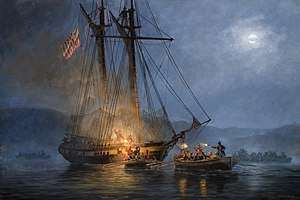USRC Surveyor
USRC Surveyor was a ship of the United States Revenue Marine captured by the United Kingdom during the War of 1812. Despite the vessel's loss, the "gallant and desperate" defense of her crew against a superior force of the Royal Navy and the Corps of Royal Marines is commemorated by the United States Coast Guard. Along with the Royal Navy frigate which bested her in battle, HMS Narcissus, Surveyor is among six legendary ships memorialized in the lyrics of the Coast Guard march "Semper Paratus".
 Painting The Gallant Defense of Cutter Surveyor | |
| History | |
|---|---|
| Name: | USRC Surveyor |
| Operator: | United States Revenue Marine |
| Laid down: | 1807 |
| Homeport: | Baltimore, Maryland, United States |
| Captured: | 1813 |
| History | |
| Name: | Unknown |
| Operator: | Royal Navy |
| Fate: | Unknown |
| General characteristics | |
| Length: | 68 ft (21 m) |
| Beam: | 19 ft (5.8 m) |
| Complement: | 25 personnel |
Construction
USRC Surveyor was laid down in 1807 and commissioned the same year.[1] Her home port was Baltimore, Maryland.[1] The ship measured 68 feet (21 m) on deck, had a 19 foot (5.8 m) beam, and carried a normal complement of 25. She was armed with six-pound cannon.[1]
War of 1812
Early war
By the War of 1812, Surveyor had become – according to one period account – "an old vessel hardly worth repairing". Still, under the command of Captain Samuel Travis, on 1 July 1812 she engaged and captured a British brig off the coast of Jamaica.[lower-alpha 1][3]
"The gallant and desperate" defense of Surveyor
The following year, on the evening of 1 June 1813 and while anchored in Chesapeake Bay, Surveyor was attacked by a Royal Navy boarding party of approximately 65 sailors and marines operating from the frigate HMS Narcissus which had entered the bay under cover of darkness.[1][2] Closing on Surveyor in small boats with muffled oars to conceal their approach, British forces navigated away from the cutter's six-pound deck guns and boarded the ship.[1] A fierce effort by Surveyor's crew to repel Royal Navy and Royal Marine boarders followed, described by British Lt John Crerie as one in which "her deck was disputed inch-by-inch" in a "gallant and desperate" defense.[1] During the engagement, Royal Marine Captain Thomas Ford was mortally wounded by Travis in a cutlass duel. Nonetheless, outnumbered more than two-to-one, Travis ultimately ordered the ship's surrender.[1] In tribute to the ferocity of Surveyor's resistance, Travis' sword was returned to him by Crerie and he was paroled at Washington, North Carolina on August 7, 1813, with the remainder of the crew transferred to a British prison camp in Halifax, Nova Scotia.[1][4]
Legacy
In 2012, in conjunction with bicentennial anniversary events commemorating the War of 1812, the United States Coast Guard commissioned the oil on canvas painting The Gallant Defense of Cutter Surveyor from Patrick O'Brien. It depicts Surveyor with her boarding net raised and her crew armed at the rails as four Royal Navy small boats converge on the ship.[6] On June 15, 2014, the defense and capture of the Surveyor was reenacted at the Watermen's Museum in Yorktown, Virginia.[7] Both Surveyor and Narcissus are among the six legendary ships from the Coast Guard's history mentioned in the second verse of its march "Semper Paratus", the others being USRC Eagle, USRC Hudson, USCGC Tampa, and HMS Dispatch.[8]
See also
- Capture of USS Chesapeake, which took place on the same day
- Defense of the Cutter Eagle – another battle between HMS Narcissus and a U.S. Revenue Marine ship
- NOAAS Surveyor – another uniformed services of the United States ship named Surveyor
- USC&GS Surveyor – another uniformed services of the United States ship named Surveyor
Notes
- In 1775, during the American Revolution, the kitchen chimney on Travis' family home in Jamestown, Virginia, was destroyed during a Royal Navy shelling.[2]
References
- Thiessen, William. "United States Coast Guard and the War of 1812" (PDF). dtic.mil. U.S. Coast Guard. Retrieved February 28, 2019.
- St. John Erikson, Mark (June 12, 2018). "A storied battle erupted on the York River on this day 205 years ago". Daily Press. Retrieved February 28, 2019.
- Allen, David (2018). United States Revenue and Coast Guard Cutters in Naval Warfare, 1790–1918. McFarland. p. 63. ISBN 1476630755.
- Nye, David (July 1, 2015). "That time the Coast Guard captured 18 ships, and 8 more surprising stories from its history". Business Insider. Retrieved February 28, 2019.
- J. J. Colledge and Ben Warlow (2010). Ships of the Royal Navy: The Complete Record of all Fighting Ships of the Royal Navy from the 15th Century to the Present, p. 390. Casemate.
- Hamilton, Sherry (May 2, 2012). "Mathews resident heads up War of 1812 commemoration". Gazette-Journal. Retrieved February 28, 2019.
- "War of 1812 on the Chesapeake Bay". watermens.org. The Watermen's Museum. Retrieved February 28, 2019.
- "Semper Paratus ("Always Ready")". nih.gov. National Institutes of Health. Retrieved February 28, 2019.